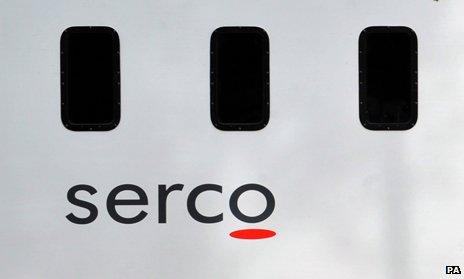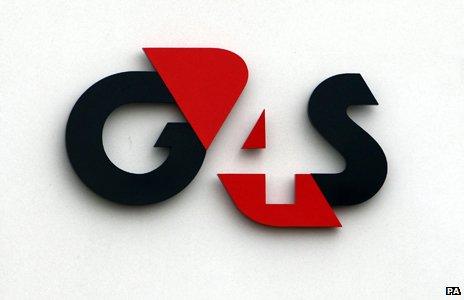Has government become too aggressive with outsourcers?
- Published
- comments

Possibly the most shocking disclosure in the National Audit Office's two reviews of how private sector companies deliver public services is how little financial information the NAO can actually demand to scrutinise.
In order to assess the important question of whether the big contractors, Serco, G4S, Atos and Capita, are making excessive profits from their £4bn of annual business with the public sector, the government's spending watchdog had to rely to a great extent on information volunteered to them by the four.
Which seems something of a lacuna, given that a huge and rising proportion of our public services are delivered by the private sector. According to the NAO, contracting out, to the likes of Serco, G4S, Atos and Capita, accounts for "around half of the £187bn that the public sector spends on goods and services each year".
Or to put it another way, contracting out represents around 15% of all public spending and 5% of UK GDP. Private sector delivery of public services is therefore hugely important to the effectiveness of the functioning of the state and to the productivity of the economy.
Yet it is only written in to some contracts that they are "open book", that the client (that's you by the way, the taxpayer) has a formal right to know how much money the private company is actually making from a particular contract.
So what did the NAO actually learn about the profitability of the big four outsourcing companies from the information they supplied?
Well the big four say that in 2012 their respective operating margins - the profits they typically make as a percentage of sales - on government contracts were lower than the operating margin they earn on average on all contracts.
So on that basis, if the numbers are reliable, it would be hard to argue that the government is being ripped off.
But there are three qualifications to make:
1. They are all making an operating margin on government work in the ballpark of 5%, with Capita and Serco apparently generating a smidge more than Atos and G4S. But is there anything magical and appropriate about that 5% number?
Now the NAO points out that the net margin for these companies for all their work - for public-sector and private-sector work - is a bit less than the average for FTSE 100 companies.
But that may not be a useful comparison. Given the long term nature of the public-sector contracts, and that once they are won they are frequently rolled over and extended, would it be reasonable for the profit margin to be even less?
The NAO doesn't seem to have a view on this.
2. There is enormous variation in the profitability of different contracts, which calls into question whether the 5% average return is meaningful.
The gross profit margin (the profit before allocating overheads) for Atos on contracts varies between 3% and 22%, the range is 6-18% for Capita, it's 0-32% for G4S, and 4-13% for Serco.
Again an important question is begged, namely why there is such variation in the profitability of contracts both for individual companies and between companies?
Does this variation reflect the different degrees of risk for the contractor in each contract - which would be a reassuring explanation?
Or does it imply that there is great variation in the competence of public sector negotiators - which would warm the cockles rather less?
Again there is no definitive answer from the NAO.
3. The NAO notes that from 1 January 2006 to 30 September 2013, the value of these businesses on the stock market has risen much more than the value of FTSE 100 companies in general. In that period, the FTSE 100 index increased 26%, whereas Capita's share price rose 141% and G4S's 94%.
That would suggest investors aren't remotely worried that the profitability of government contracts is too slim.

Quite the reverse. It implies that the reliability of the revenues from these contracts is what matters, and that therefore the profit margins are quite satisfactory.
But, and this is quite important, the story of the relationship between the private-sector providers and the government is - ahem - evolving.
Since the 2010 general election, the Cabinet Office has aggressively tried to exercise greater central control over the awarding of outsourcing contracts.
In the process, it has obtain substantial refunds on older deals and seems to be securing better value for money on new transactions.
More recently the Ministry of Justice has duffed up Serco and G4S, by calling in the Serious Fraud Office to investigate alleged overcharging for electronic tagging of criminals.
Or to put it another way, the perceived balance between risk and reward on these outsourced deals is changing, to the detriment of the private sector businesses.
There have been big management changes at Serco and G4S, and their share prices have both fallen by around a sixth since May.
So probably the most interesting conclusion by the NAO is the one that goes against the grain of typical political and public discourse about private sector providers.
The NAO warns the Cabinet Office that there is a limit to the financial squeeze it can put on the likes of the big four, and that it may not be too long before there will be a loss of "innovation and investment" which "could pose a risk to value for money in the longer term".
The watchdog takes seriously the private sector providers when they say they may choose not to bid for future contracts in certain public services.
And that could be a problem, because - with so much outsourced since the 1980s - it is not obvious that the public sector retains the competence and skills to take back some of these services.
Or to return to where I started, given that public and private sectors are now so intimately and intricately combined, it may not be unreasonable for the taxpayer as employer to have much clearer sight of how much profit the contractor is earning.